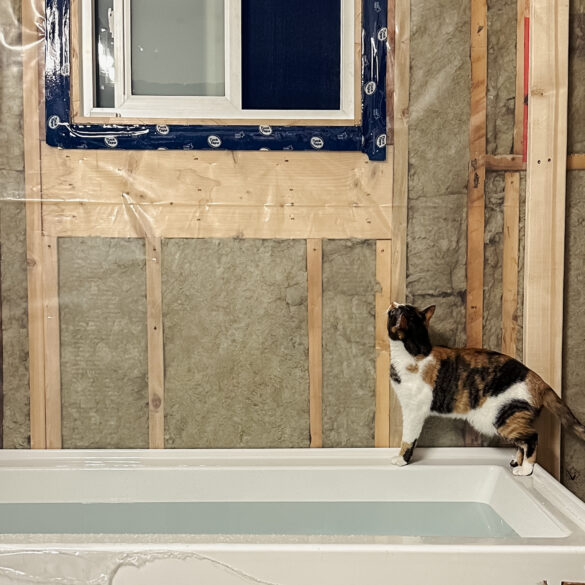After taking down our one and only tree on our property, we knew we needed to get some other foliage growing! My husband is a self-proclaimed “super ginger” with his Iris and Scottish ancestry, and I’ve been called a day-walker more times than I’d like to admit. Mix this with living in the Canadian desert, shade is something we need to enjoy our yard!
Yes, we know that a tree doesn’t suddenly grow to 20 feet overnight, but the sooner we plant, the sooner it grows – right? That’s what I’m telling myself!
Now, I’m pretty new to this whole keeping plants alive thing, and honestly never really paid much attention to trees in people’s yards as I was normally hiding with allergy pills and tissue. Turns out there’s more than like 3 types? Wild times.
There are some steps though we’ve notice that we keep applying to every tree we look at that I’d thought I would share with you.
Start here before buying a tree!
1. Locate where your sewer, water, and gas lines are! Some trees have some deep or wide-spreading roots and you will want to know how close you are to these lines when looking at trees. In BC, it is the law that you call Call Before You Dig to give the location of where you want to plant, otherwise you could be on the hook for some high costs if you hit a gas line! This is also where you want to note any power lines – thankfully this is not an issue for us!
2. What is your growing zone? I’m sure there are ways to google this, but in areas like mine, we have several different growing zones in one city! So I just stick to asking the professionals at landscaping stores 😉 For us, we are a zone 6 which is the highest in our city, so most of our stores don’t carry above a zone 5. This means we can grow anything from zones 1-6 without worry, and the lower the number, the hardier it will be!
3. How tall are you wanting the tree to go? Maintenance? Are you wanting shade, fruit, or just ornamental? List your goals/ideals for the tree you want so you can compare to the tree facts when you shop around! After having a 60 foot tree, we know we don’t want anything that goes above 40 feet tall. We also know we don’t want to plant too far into our yard, so we are looking for canopies under 30 feet wide, with shade being the most important feature. We don’t care about raking up leaves in the fall, but really don’t want to be dealing with fruits or nuts!
4. Go look at some trees! This can be around your neighborhood, in stores, online – whatever you would like! We enjoy going for a walk nearly every day, and have been taking note of trees and shapes we like as we go. I think we’ve also been to every nursery in town! There are also apps you can get on your phone to take pictures of plants and it will tell you what it is! I personally use Picture This and while it’s not always accurate, it does help most of the time! Make a list of the trees you like.

5. Check your tree facts! Look for key words online like “invasive” and “sewer seeking” “foundational damage”. The main things we check on each tree are: height at maturity, canopy spread, and root spread. Some roots will go out from the tree 40ft+ . Unlike canopy spread which is from tip to tip, root spread is that straight! Some trees are known to cause more damage than others (hello weeping willows). I LOVED aspens, but they would not work with our area! I would also look for things like what type of soil the trees like at this point to see if it matches your soil or if you need to get some fertilizers but the landscaping stores should be able to help with that!
5b. How much water will it need? This might not matter to you, but we live in an area with water restrictions on from May to October every year. This means we can only use our sprinklers on the days we’re given (we are an odd number house, so we can water on odd days). You are allowed to hand water, and care for new trees though! But still, we don’t want to have a sky-high water bill if we can avoid it! Some trees/shrubs/hedges will require more water than others. Our city has a list of how much water each type of tree needs in our climate, but I’m sure a quick google will tell you too – or talk to your neighbors and see if you can learn from their mistakes! Example: cedar hedges are popular here… but the first few years you’re looking at HEFTY water bills trying to keep those suckers alive! My coworker who lives 4 blocks overspent $1000 on her water bill in THREE MONTHS for them. They’re off of our list!
6. Buy your tree! You’re now aware of what trees will suit your yard and needs the best, and shouldn’t have any surprises as it grows older. Dig your hole (general rule is 2X the width and depth of your root ball), water thoroughly, add some transplanting fertilizer if you wish. And enjoy watching your new addition to your yard.
Happy planting, friends! Let me know what trees you just LOVE for your landscaping!
Miss something? Make sure you check out our most recent posts here!












Comments are closed.